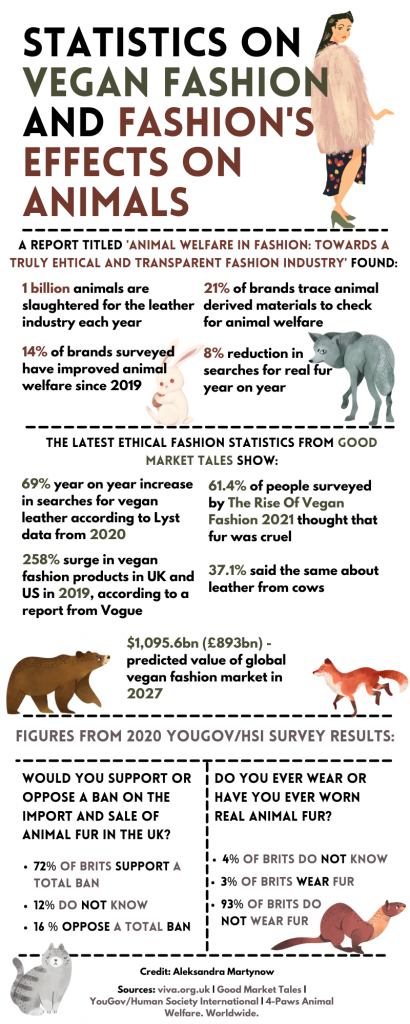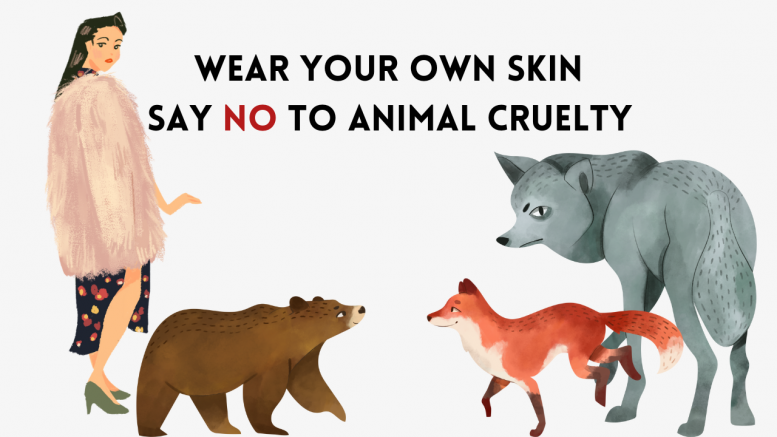A fur coat, gorgeous pair of leather shoes and a bag to match with a side of animal cruelty. That is the unfortunate reality of fashion.
Animal skins have been used for centuries for shelter and protection from the cold. At some point in time, that shifted and animal skins became a part of fashion. From the 14th to 17th century, fur was used for clothing worn by the elites and aristocrats. It was a symbol of social status and wealth and was meant to establish a hierarchy in society.
Wearing fur allowed people to proclaim a more refined identity. Particularly exclusive furs included marten, fox, and ermine. Fur continued to be used as an identity mark for the elite in the 19th and 20th centuries. Even now, in the 21st century, fur coats are subject to luxury and material wealth, and so are expensive shoes made out of leather.
While importing and using fur for fashion is considered an outcome of excess capitalism, fur has always been central to many societies for survival. Due to its “excellent thermal qualities” fur has been and is still utilised in some of the world’s harshest climates. For some societies fur is a part of their culture, on top of that, some animal skins are the only resource they can use due to their availability and ease.
Leather
An undercover exposé by PETA in 2014 revealed that in China, dog and cat skin were being exported to other countries under the pretence of them being cow skin. This caused unbelievable public outrage, however, how is wearing cat or dog skin different from wearing the skin of any other animal?
According to PETA, every year 1.4 billion animals are killed for leather production. The numbers include cows, sheep, water buffalos, goats, kangaroos and pigs. These animals have the same feelings as cats and dogs, however it seems like not many people would bat an eyelid.
If that wasn’t enough, leather is often made from the skins of cattle who have been first used for their milk and flesh. Agricultural organisations refer to leather as a co-product. By buying leather we are also supporting industries that forcibly impregnate animals, separate the babies from their mothers, perform mutilations and later take them to slaughterhouses where their lives are ended in horrific ways.
In recent years a few alternatives have been developed like coffee leather, made out of coffee grounds mixed with natural pigments and liquids like glycerine, oil and water. The mixture is poured into moulds and air-dried for a few days.
Vietnamese designer Uyen Tran has developed a flexible bio-material called TômTex– a leather alternative made from food waste. The material can be embossed with patterns to replicate a variety of animal leathers. The name tôm, meaning shrimp, references the discarded seafood that is mixed with coffee grounds to produce the eco-textile.
This is just the beginning of a long process of ending the usage of animal skins. Despite the process of elimination being slow, fashion universities are making sure to teach future designers how to find, source, produce and use cruelty-free, eco-friendly alternatives.
A textile course at the University of Birmingham teaches their students how to produce vegan leather alternatives and allows young designers to experiment.
Mahawa, a recent graduate, said: “In the three years of university, not once have I used any kind of fabric of animal origin. We have learnt how to create ‘leather’ out of coffee waste and were able to experiment with the processes.”
Fur
When it comes to fur, one might argue the situation is even worse. However, we should not be pitting two ‘tragedies’ against each other. Fur and the fur industry are one of the most controversial topics in the fashion world.
Animals used for fur are kept in tiny cages, unable to move and with no food. Companies responsible for the ‘production’ of fur put the quality and well-being of the fur itself over the animals it belongs to. Their bodies are seen as disposable, all that matters is the harvested fur that’s taken care of better than the poor creatures murdered after living a short and horrid life full of pain.
Remember that one scene from Sex and the City, where activists threw red paint at Samantha’s white fur coat? Well, although that doesn’t happen as much anymore, if at all, other forms of activism have replaced it.
Recently, PETA teamed up with a host of young London designers to write a letter to Central Saint Martins. The aim of it was to urge the students to not use fur and take aim at fur companies who sponsor students’ collections and offer them the use of those expensive materials.
In recent years many big names and legendary fashion designers have decided to move away from the use of furs. Stella McCartney has pioneered the world’s first faux fur that is made from bio-based materials, which led the way for others to develop biodegradable and sustainable fur substitutes.
A few years back, Giorgio Armani made an agreement with ‘The Fur Free Policy’ to remove all products made with animal fur from the Autumn-Winter 2016/17 season onwards.
Other big names like Calvin Klein, Ralph Lauren, Gucci, Diesel and many more have also moved away from the use of real fur. Even fast fashion giants like H&M are slowly announcing new vegan collections. The suffering of animals has gone out of fashion.
Eden, who graduated from the London College of Fashion last year, has said that fashion courses are moving towards sustainable, more eco-friendly materials. She said: “We were urged to not use fur, leather etc. If we did decide to use materials that came from animals, we sourced them second hand.”
“If from the beginning we’re taught not to use textiles that come from animals, that are sourced in such inhumane ways, we will have the power to one day free the fashion industry from animal cruelty.”
It is important to remember that you do not have to be rich to pay for and wear cruelty. Consumers are often unaware that they are in fact purchasing fur products, due to mislabelling. Even the bobble on your winter hat could be made out of real fur.
There is, however, some good news. Fur farming has been banned in many countries, including Austria, The Netherlands and Slovenia, among others. Despite fur farming being banned in 2003, the UK still allows fur products to be imported from overseas. Fortunately, there are calls to ban the importation of fur into the UK after Brexit.

The British Fur Trade (BFTA), which is the voice of the UK fur sector, argues that fur is “the natural and slow solution to fast fashion”. Their priorities lay in highlighting the environmental impacts of fast fashion and the sustainability of faux fur. However, faux fur does not mean plastic anymore. There are new ways to produce the cruelty-free textile, by using compostable materials and hemp fibres from cannabis plants.
PETA, the opposing side, argues that harming animals is not the better option, and explains that fur farming, just like all other factory farms, has little regard for the welfare of the animals or the environmental impact. While harvesting fur, tonnes of faeces can run into nearby streams or rivers, causing a harmful emission of ammonia and nitrous oxide.
Carmen, a textiles lecturer, said: “We can have both. We can protect the environment and end animal cruelty. It is not an either-or situation. We have to continue researching and developing new sustainable ways to preserve both, the planet and innocent animals.”
Nobody can deny that skinning animals alive in the name of fashion and profit, is hardly an act of humanity or morality.
Words: Aleksandra Martynow | Subbing: Yana Trup


Be the first to comment on "Animal cruelty is SO out of fashion"